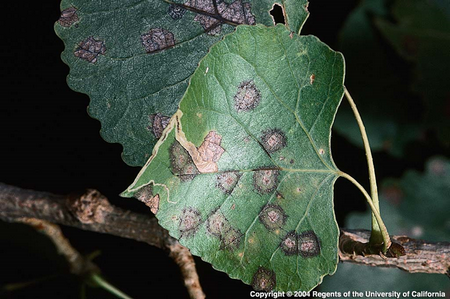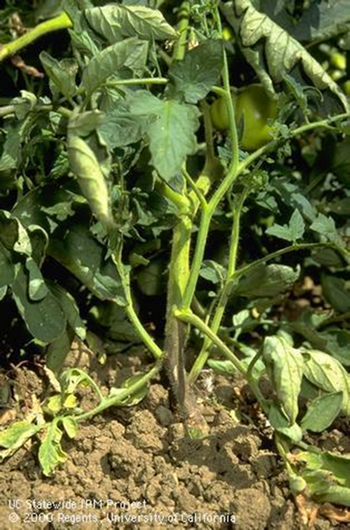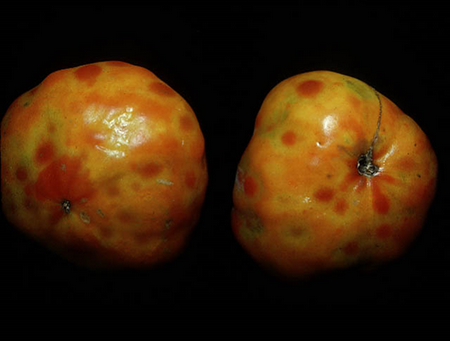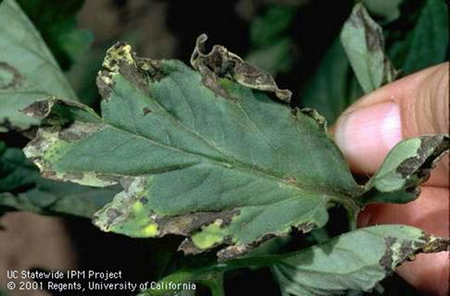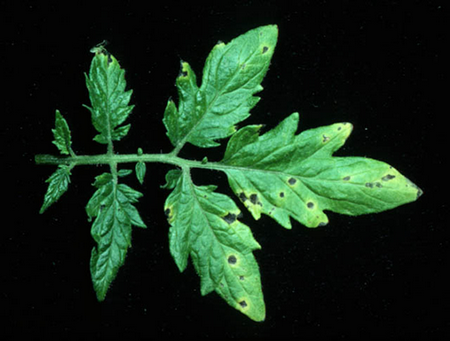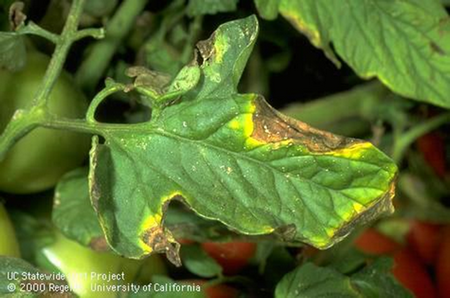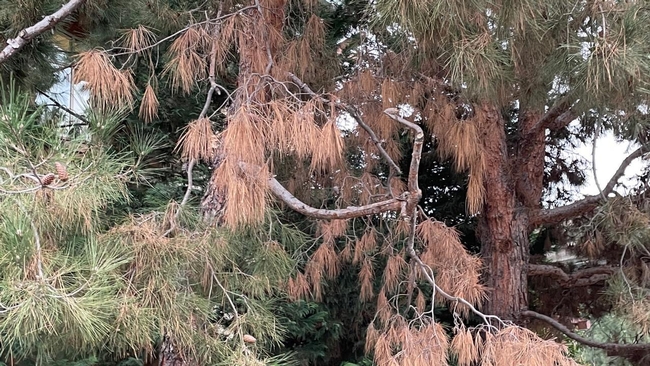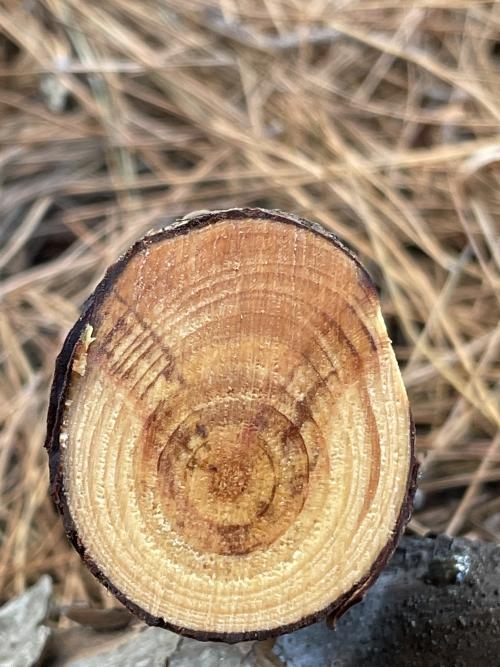Posts Tagged: Canker
Avocado Cankers
Avocado Trunk Cankers
This has been a low rainfall year, and often with the low rainfall, cankers will seem to suddenly appear on the woody parts of the tree. There are a number of causes for the white exudate from cankers on the trunk and limbs of avocado. Any wound will cause the tree sap to run and crystalize on the surface. It is a seven carbon sugar of mannoheptulose, or its alcohol form perseitol. It's sweet. So any wound that might be caused by woodpeckers or little kids climbing the trees will damage the bark, and where the damage has occurred, the sugar will form. There are also diseases that can cause a wound that will exude the sugar. Three of these are due to water stress of some form that allows infection to occur. One of these is bacterial – Bacterial Canker. Another is caused by a fungus which in the past was called Dothiorella Canker. We now know it by a different name and a UCR plant pathologist has actually identified seven different species of fungus that invade the wood and can eventually weaken the tree so limbs can break and the tree becomes unthrifty. In the case of very young trees, they can be killed by the fungus. A third cause of sugary cankers is Black Streak, the cause of which was unclear until recently when Dr. Akif Eskalen possibly identified it. It was coming from a similar set of fungi that cause Dothiorella Canker. It makes sense, because in all three of these cases, they most often appear after a low rainfall year, where pressures in irrigation systems are insufficient, where emitters have clogged and where water or salinity stress have occurred. The bacteria and fungi that cause these cankers are widely distributed in most orchards and are just waiting for the stressed tree to appear. The grower just needs to identify where this stress is occurring, correct the problem (clogging, low pressure, poor irrigation design, infrequent scheduling, inadequate leaching, etc.) and if the damage is not too extensive, often these symptoms will disappear with time.
The fourth cause of canker is caused by Phytophthora citricola, a relative of avocado root rot. This is caused by a moist trunk, either from irrigation water hitting the trunk, or on the north side of the tree that doesn't dry out from morning dew. This is a much slower acting disease than root rot, although it can rapidly kill young trees. The cankers occur at about 18 inches from the ground and gradually girdle the tree. The first thing to do before ever seeing this disease is to make sure irrigation water isn't hitting the trunks. If cankers appear, they respond to the same materials used for root rot, but should actually be sprayed right on the canker.
Images
Top: Black Streak can occur on trunks or branches as small, scattered cankers. The name comes from the blackening that occurs around the infected area.
Next: Bacterial Canker causing discrete silver dollar-sized cankers. The exudate running down from the bottom edge results when a knife is poked into it. The cankers tend to run in a line up the trunk or branch.
Next: Citricola crown rot with the cankers girdling the trunk. It appears near the ground.
Bottom: Dothiorella Canker (soon to have a new name) can occur anywhere on the trunk or branches

black streak

bacterial canker

citricola

dothiorella canker
Lawn-pocalypse! Surviving Drought
Ah, summer! The season of sunburns, pool parties, and… lawn droughts. If your once lush, green carpet now looks like a crunchy brown doormat, you're not alone. Let's dive into why your yard is staging a dramatic death scene and what you can do to...

Bermuda grass and weeds overtaking drought stressed turf grass.
Tomato Diseases in the Home Garden
As tomato growers, we might consider any ailing tomato to have a disease. That would end up making this blog post really, really long. However, we need to consider diseases separately from damage done by pests (both vertebrate and invertebrate—see blog post from July 18: Tomato Diseases in the Home Garden) or environmental disorders such as blossom end rot (see blog post from July 4: https://ucanr.edu/blogs/blogcore/postdetail.cfm?postnum=57297). We will cover fungal, viral, and bacterial diseases here.
Fungal
The most common tomato diseases are fungal. Many of these fungal spores are nearly everywhere all the time, and given the right conditions, will find a home on your tomato plants. Some fungi prefer cool conditions while some prefer warm. Most prefer wetness and high humidity. Crowding can prevent proper air circulation and encourage fungal diseases. Nutritional deficiencies and injuries also encourage fungal diseases.
Damping Off Disease typically affects seedlings. It's caused by various soil fungi that grow under damp conditions. The affected tap roots of seedlings in contaminated, overly damp soil are dark and mushy and the seedlings usually die. Prevent this by using fresh clean soil and sanitized containers with good drainage. Use alcohol or a 10% bleach solution to sanitize. https://ipm.ucanr.edu/PMG/PESTNOTES/pn74132.html
Septoria Leaf Spot is favored when plants are exposed to cool, rainy weather or splashing from soil. It's relatively uncommon in Contra Costa County. Prune off infected leaves and twigs and keep plants dry. https://ipm.ucanr.edu/PMG/GARDEN/PLANTS/DISEASES/septorialfspot.html
Phytophthora Root and Crown Rot is a soil-borne fungus-like organism transmitted under wet conditions by splashing water or contaminated garden debris, pots, or tools. Plants appear drought-stressed since the vascular system is compromised, and often die. It can also cause damping-off. Look for darkening of the crown, roots, and stems. Good drainage, avoiding overwatering, and sanitizing any tools used on the diseased plants are preventive measures. In previously affected soil, avoid planting members of the Solanaceae family (tomatoes, eggplant, peppers, potatoes) in the infected soil and plant a resistant crop instead such as corn. https://ipm.ucanr.edu/PMG/PESTNOTES/pn74133.html
White Mold, also called Cottony Soft Rot, appears as bleached areas on stems from white mycelia. Fruit can be affected and appears gray. The mold favors hot, moist conditions and often spreads from dying flowers. Bury or dispose of infected tissue; avoid overhead watering, overwatering, and crowding. https://ipm.ucanr.edu/PMG/GARDEN/VEGES/DISEASES/tomwhmold.html
Powdery Mildew looks different on artichoke, pepper, and tomato leaves from its appearance on other plants (see reference). It requires warm weather and living tissue to grow but does not require moist conditions. Prevention includes planting resistant varieties in sunny areas and avoiding crowding. Occasionally a fungicide or a biologic is needed. https://ipm.ucanr.edu/PMG/PESTNOTES/pn7406.html
Early Blight's name is somewhat misleading as it occurs on mature tomato plants and can affect fruit. It is uncommon in our Mediterranean climate. See reference for photos, prevention, and treatment: https://ipm.ucanr.edu/PMG/GARDEN/VEGES/DISEASES/tomearlyblight.html
Late Blight (Phytopthora infestans) occurs in our coastal areas and is favored by average temperatures and high humidity. It can spread rapidly from other Solanaceae family members or their cullings. Avoid overhead sprinkling and crowding of plants and buy certified blight-free seeds and tubers. Dispose of affected plants and debris in green waste. https://ipm.ucanr.edu/PMG/GARDEN/VEGES/DISEASES/lateblight.html
Black Mold typically affects ripe tomato fruit during conditions of warmth and high humidity. It can appear as small dark brown spots or grow into large, sunken areas. Pick fruit as soon as it ripens. https://ipm.ucanr.edu/PMG/GARDEN/VEGES/DISEASES/tomblkmold.html
Verticillium and fusarium wilt are fungal diseases that will be discussed in an upcoming blog.
Viral
Tobacco Mosaic Virus is a disease primarily of Solanaceae, of which tobacco is a member. It is transmitted by infected seeds or by tobacco residue on the hands of smokers. The leaves appear mottled and stringy, but the fruit is edible. Herbicide damage can appear similar. Many tomato cultivars have resistance. https://ipm.ucanr.edu/PMG/GARDEN/VEGES/DISEASES/tobaccomosvir.html
Curly Top Virus and Spotted Wilt Virus are fairly unusual afflictions. Curly Top Virus is carried by the beet leafhopper and causes curling, puckering, and stunting of leaves. Fruit is usually discolored and small. Spotted Wilt Virus is transmitted by the western flower thrip. It can be difficult to diagnose as it presents differently depending on the stage of plant growth. Fortunately, it's rare in Contra Costa County. Both have wide host ranges. For severe infections in the garden, testing may be warranted since the viruses can mimic other diseases. Affected plants will need to be removed and disposed of. Unfortunately, insecticides do not kill thrips or leafhoppers in time once the damage has been noticed. https://ipm.ucanr.edu/PMG/GARDEN/VEGES/DISEASES/curlytop.html
https://ipm.ucanr.edu/PMG/GARDEN/VEGES/DISEASES/tomspotwltvir.html
Bacterial
Bacterial Speck, Bacterial Spot, and Bacterial Canker are all easily confused. They tend to be introduced on infected seeds, and can overwinter on garden debris, flats, and stakes. They all prefer wet conditions. All three cause lesions on fruit. Speck and Spot cause similar leaf lesions and are chiefly distinguished by their appearance on fruit.
Bacterial Speck prefers cooler conditions such as in coastal regions. A Pseudomonas bacterium causes small sunken spots with white halos that can become scabby. The leaf spots are similar and appear greasy, and leaf margins can turn brown in an angular pattern. Stems can also be affected.
Bacterial Spot is caused by Xanthomonas bacteria, resulting in large, black, sunken spots on fruit and irregular black spots on leaves. Warm, humid conditions favor its appearance. The fruit may be eaten once the black spots and any underlying maceration are removed. https://u.osu.edu/vegetablediseasefacts/tomato-diseases/bacterial-leaf-spot/basics/
Bacterial Canker also prefers warm, humid conditions. Stunting, wilting, scorching of leaf margins, cankers on stems, and vascular discoloration are distinguishing features.
https://ucanr.edu/blogs/blogcore/postdetail.cfm?postnum=27926&postnum=27926
Bacterial diseases can be managed somewhat with copper sprays and these sprays are acceptable for organic farming.
Prevention
Prevention is the ideal way to manage all these diseases:
• Rotate crops
• Don't overwater or spray the plant
• Don't crowd plants
• Remove lower leaves that can touch the soil
• Use mulch to prevent spread from soil
• Buy resistant varieties
• Control weeds to prevent thrip and leafhopper invasions
• Dispose of infected plant parts and debris, sanitize tools, planting flats, and hands
• Baby heirloom tomatoes because they typically have little resistance
For more information about pests and diseases of tomatoes, see this website: https://ipm.ucanr.edu/home-and-landscape/tomato/index.html
Help Desk of the UC Master Gardeners of Contra Costa County (EAS)
Climate-Change Resources
University of California UC ANR Green Blog (Climate Change and Other Topics) https://ucanr.edu/blogs/Green/index.cfm?tagname=climate%20change (full index)
Examples:
- Save Trees First: Tips to Keep Them Alive Under Drought https://ucanr.edu/b/~CdD
- Landscaping with Fire Exposure in Mind: https://ucanr.edu/b/~G4D
- Cities in California Inland Areas Must Make Street Tree Changes to adapt to Future Climate https://ucanr.edu/b/~oF7
Drought, Climate Change and California Water Management Ted Grantham, UC Cooperative Extension specialist (23 minutes) https://youtu.be/dlimj75Wn9Q
Climate Variability and Change: Trends and Impacts on CA Agriculture Tapan Pathak, UC Cooperative Extension specialist (24 minutes) https://youtu.be/bIHI0yqqQJc
California Institute for Water Resources (links to blogs, talks, podcasts, water experts, etc.) https://ciwr.ucanr.edu/California_Drought_Expertise/
UC ANR Wildfire Resources (publications, videos, etc.) https://ucanr.edu/News/For_the_media/Press_kits/Wildfire/ (main website)
-UC ANR Fire Resources and Information https://ucanr.edu/sites/fire/ (main website)
-Preparing Home Landscaping https://ucanr.edu/sites/fire/Prepare/Landscaping/
UC ANR Free Publications https://anrcatalog.ucanr.edu/ (main website)
- Benefits of Plants to Humans and Urban Ecosystems: https://anrcatalog.ucanr.edu/pdf/8726.pdf
-Keeping Plants Alive Under Drought and Water Restrictions (English version) https://anrcatalog.ucanr.edu/pdf/8553.pdf
(Spanish version) https://anrcatalog.ucanr.edu/pdf/8628.pdf
- Use of Graywater in Urban Landscapes https://anrcatalog.ucanr.edu/pdf/8536.pdf
- Sustainable Landscaping in California https://anrcatalog.ucanr.edu/pdf/8504.pdf
Other (Non-UC) Climate Change Resources
Urban Forests and Climate Change. Urban forests play an important role in climate change mitigation and adaptation. Active stewardship of a community's forestry assets can strengthen local resilience to climate change while creating more sustainable and desirable places to live. https://www.fs.usda.gov/ccrc/topics/urban-forests
Examining the Viability of Planting Trees to Mitigate Climate Change (plausible at the forest level) https://climate.nasa.gov/news/2927/examining-the-viability-of-planting-trees-to-help-mitigate-climate-change/
Reports and other information resources coordinated under the auspices of the United Nations and produced through the collaboration of thousands of international scientists to provide a clear and up to date view of the current state of scientific knowledge relevant to climate change. United Nations Climate Action
Scientific reports, programs, action movements and events related to climate change. National Center for Atmospheric Research (National Science Foundation)
Find useful reports, program information and other documents resulting from federally funded research and development into the behavior of the atmosphere and related physical, biological and social systems. Search and find climate data from prehistory through to an hour ago in the world's largest climate data archive. (Formerly the "Climatic Data Center") National Centers for Environmental Information (NOAA)
Think tank providing information, analysis, policy and solution development for addressing climate change and energy issues (formerly known as the: "Pew Center on Global Climate Change"). Center for Climate & Energy Solutions (C2ES)
Mapping Resilience: A Blueprint for Thriving in the Face of Climate Disaster. The Climate Adaptation Knowledge Exchange (CAKE) was launched in July 2010 and is managed by EcoAdapt, a non-profit with a singular mission: to create a robust future in the face of climate change by bringing together diverse players to reshape planning and management in response to rapid climate change. https://www.cakex.org/documents/mapping-resilience-blueprint-thriving-face-climate-disaster
Cal-Adapt provides a way to explore peer-reviewed data that portrays how climate change might affect California at the state and local level. We make this data available through downloads, visualizations, and the Cal-Adapt API for your research, outreach, and adaptation planning needs. Cal-Adapt is a collaboration between state agency funding programs, university and private sector researchers https://cal-adapt.org/
Find reports, maps, data and other resources produced through a confederation of the research arms of 13 Federal departments and agencies that carry out research and develop and maintain capabilities that support the Nation's response to global change. Global Change (U.S. Global Change Research Program)
The Pacific Institute is a global water think tank that combines science-based thought leadership with active outreach to influence local, national, and international efforts to develop sustainable water policies. https://pacinst.org/our-approach/
Making equity real in climate adaptation and community resilience policies and programs: a guidebook. https://greenlining.org/publications/2019/making-equity-real-in-climate-adaption-and-community-resilience-policies-and-programs-a-guidebook/
Quarterly CA Climate Updates and CA Drought Monitor Maps (updated each Thursday) https://www.drought.gov/documents/quarterly-climate-impacts-and-outlook-western-region-june-2022
Fungi that causes pine ghost canker detected in Southern California trees
Pathogen native to U.S. but had not infected pines until recently
Fungal pathogens that cause die-back in grape, avocado, citrus, nut and other crops has found a new host and is infecting conifer trees causing pine ghost canker in urban forest areas of Southern California.
The canker can be deadly to trees.
Scientists from University of California, Davis, first spotted evidence that the pathogens had moved to pines during a routine examination of trees in Orange County. Over four years, they found that more than 30 mature pines had been infected in an area of nearly 100 acres, according to a report in the journal Plant Disease.
Akif Eskalen, a professor of Cooperative Extension in the Department of Plant Pathology at UC Davis, suspects drought and other stress conditions brought on by climate change weakened the tree species, making it more susceptible to new threats.
“We have been seeing this on pine trees for the last several years,” he said. “Our common crop pathogens are finding new hosts.”
Pine ghost canker – caused by the fungal pathogens Neofusicoccum mediterraneum and Neofusicoccum parvum – usually infects the lower part of a tree's canopy, killing branches before moving on to the trunks. This dieback in some cases can be deadly.
Points of entry
The pathogens infect a tree by entering through wounds caused by either insects such as red-haired pine bark beetles or pruning – meaning trees in managed or landscaped areas could be at risk. Another route is via tiny natural openings known as lenticels that fungi can make their way through, said Marcelo Bustamante, a Ph.D. candidate in Eskalen's lab who is first author on the paper.
Spores from the fungi can disperse and the higher the prevalence means an increased chance of transmission. Rain, irrigation water and humidity by fog can trigger the right circumstances for the spores to spread, he said.
“The detection of these pathogens in urban forests raises concerns of potential spillover events to other forest and agricultural hosts in Southern California,” Bustamante and others wrote in the report.
Dead branches can indicate a canker. Detecting the fungi is not an emergency but “people should keep an eye on their plants when they see abnormalities,” Eskalen said.
Cankers are localized areas on stems, branches and tree trunks that are usually dead, discolored and sunken. On bark, the spores can look like strings of discolored dots.
The lab has posted a brochure bout how to best manage wood canker diseases.
Tips include:
* Keep your trees healthy: Proper irrigation and maintenance will keep trees strong.
* Prune dead branches to reduce sources of infestation.
* Avoid unnecessary pruning; perform structural pruning only.
Karina Elfar, Molly Arreguin, Carissa Chiang, Samuel Wells and Karen Alarcon from the Department of Plant Pathology contributed to the paper, as did experts from Disneyland Resort Horticulture Department, State University of New York's College of Environmental Science and Forestry, UC Irvine and UC Los Angeles.

